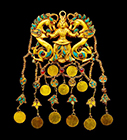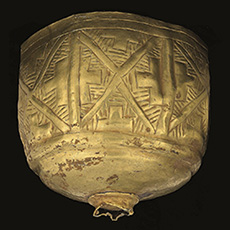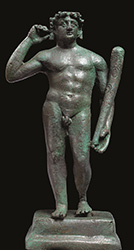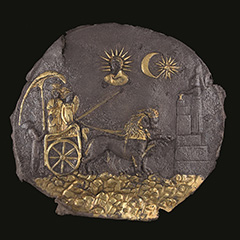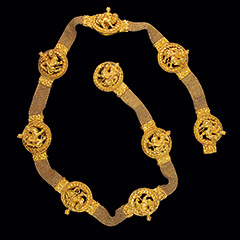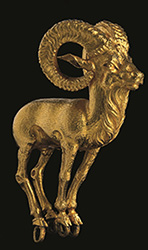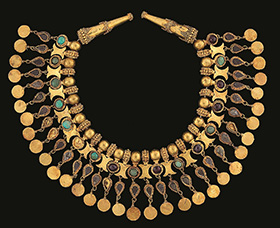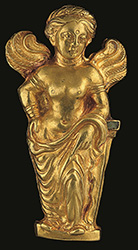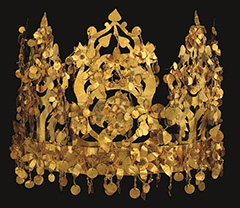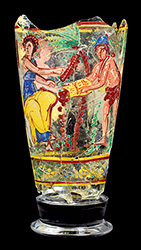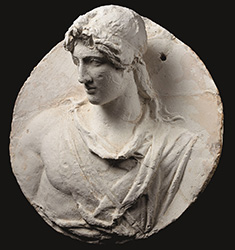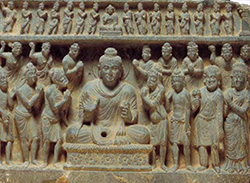Highlights of the Exhibition
Chapter 1 Tepe Fullol
Gold, bronze, tin, lapis lazuli, garnet, carnelian are all mineral resources of Afghanistan. Pioneers stepped onto mountain range of Hindu Kush. A distinctive culture with its own architectural technique developed at the beginning of the Bronze Age (around 2200BC). During the Bronze Age numerous architectures constructed with massive stone slabs were built, and this architectural style continued for several centuries. As there is Oxus River, architects call this Oxus Civilization, although formal name is unknown since no record of the Bronze Age has been found. In 1966 a farmer living in northern Afghanistan (Fullol) first discovered Oxus tomb. Containers displayed in the exhibition were also discovered from the tomb.
Goblet with geometric motif
2100-2000 B.C.
National Museum of Afghanistan
Page top
Chapter 2 Aï Khanum
Ai Khanum was a Greek colonized city in northern Afghanistan within the land of Bactoria. Ai Khanum, which translates to “Lady Moon”, was founded in in the late 4th century BC following the conquests of Alexander the Great. The site was excavated starting in 1964, by a French DAFA mission led by Paul Bernard. Excavated objects from the site point to Greco-Bactorian Kingdom and Indo-Greek Kingdom civilizations, and present Greek influence onto Buddhist art. A gilded ceremonial silver plate (lower right image) depicts a mother goddess Cybele and a goddess of victory Nike riding a central Asian war carriage watched over by Helios, the personification of the Sun. The combination of Greek gods with local artistic rendering is an important example of cultural exchange between Greece, West Asia, and Ancient Orient.
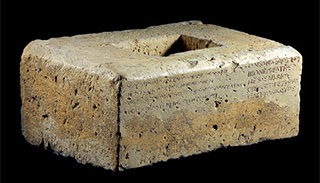 Stele base with inscription
Stele base with inscription
Early 3rd century B.C.
National Museum of Afghanistan
Statuette of Heracles
ca. 150 B.C.
National Museum of Afghanistan
Cybele Plaque
3rd century B.C.
National Museum of Afghanistan
Page top
Chapter 3 Tillya Tepe
Bactoria, located in northern area of Afghanistan, flourished as Greco-Bactorian Kingdom until it was invaded by Central Asian nomads in 145BC. Tillya Tepe translates to “Hill of God”. When the site was excavated in 1978, a tomb of a nomadic leader thought to be buried around 100BC was discovered, along with a tomb of other tribal members (5 females). These artifacts are called “Bactorian gold” and includes various ornaments, jewelries, and gold pieces used to adorn garments. These findings point to extravagant outfits of nomads.
The nomads that arrived in Bactoria interacted and exchanged cultures and developed a unique civilization combining Greek, Ancient Roman, Indian, and Chinese elements. “Bactorian gold” is one of the prominent objects of the exhibition. Each piece, although small, shows delicate execution of shape and design.
Adorable depictions of local and mythical animals also captures the eyes of viewers. the combination of gold and turquoise is exquisite.
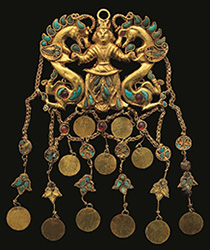
Pendants with Dragon Master
Second quarter of the 1st century A.D.
National Museum of Afghanistan
Belt with medallions
Second quarter of the 1st century A.D.
National Museum of Afghanistan
Standing ram
Second quarter of the 1st century A.D.
National Museum of Afghanistan
Ornament for the neck of a robe
Second quarter of the 1st century A.D.
National Museum of Afghanistan
Applique of Aphrodite
Second quarter of the 1st century A.D.
National Museum of Afghanistan
Crown
Second quarter of the 1st century A.D.
National Museum of Afghanistan
Page top
Chapter 4 Begram
Begram, located in northern area of Afghanistan, was once a focal trading point on the Silk Road. From 1930s to 40s extensive excavations were carried out by French archaeologists. In a site called “palace”, various precious objects such as Greco-Roman bronze statues, enameled glass goblets from the Ancient Roman Egyptian
city Alexandria, Chinese lacquerware, and ivory statues that did not even survive in India were discovered.
These objects date back to Kushan Empire. The latest study also point out that Begram was a primary point of trade and manufacture of Kushan Empire that spread its power all the way down to Ganges region in India. The objects were found hidden underneath deliberately placed rocks. It is speculated that an individual heading
out to a long journey on the Silk Road have covered the artifacts. And for whatever reason the person never returned and the artifacts were left untouched for over 2000 years.
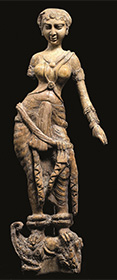
Woman standing on a makara
1st century A.D.
National Museum of Afghanistan
Painted goblet
1st century A.D.
National Museum of Afghanistan
Circular medallion (torso of a young man)
1st century A.D.
National Museum of Afghanistan
Page top
Chapter 5 Displaced Cultural Properties from Afghanistan
At the height of the turmoil in Afghanistan, countless cultural properties were pillaged from the National Museum in Kabul and raided from various archaeological sites then smuggled out of the country. Some of these made their way to Japan. The Japanese painter HIRAYAMA lkuo, whose life’ s work focused on paintings of the Silk Road, proclaimed this flood of�cultural properties leaving the region to be “cultural properties refugees" and established the Japan Committee for the Protection of Displaced Cultural Properties with the approval of� UNESCO in 2001. The committee advocated the safeguarding of such items in Japan until peace and stability returned to Afghanistan, The cultural properties that were turned over by�individuals endorsing this mandate have been provided protective care under said committee and it has been decided that a total of 102 works can now safely be returned to�Afghanistan. This exhibition offers the opportunity to feature a special selection of fifteen of these cultural properties in anticipation of their return.
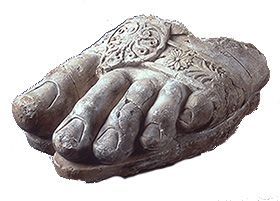
Left Foot of Zeus
3rd century B.C.
Aï Khanum
Held in trust by the Japanese Committee for the protection from Dispersement of Cultural Properties
Buddha worshipped by Kasyapa Brothers (detail)
2nd-3rd century A.D.
Shotorak
Held in trust by the Japanese Committee for the protection from Dispersement of Cultural Properties
Page top

